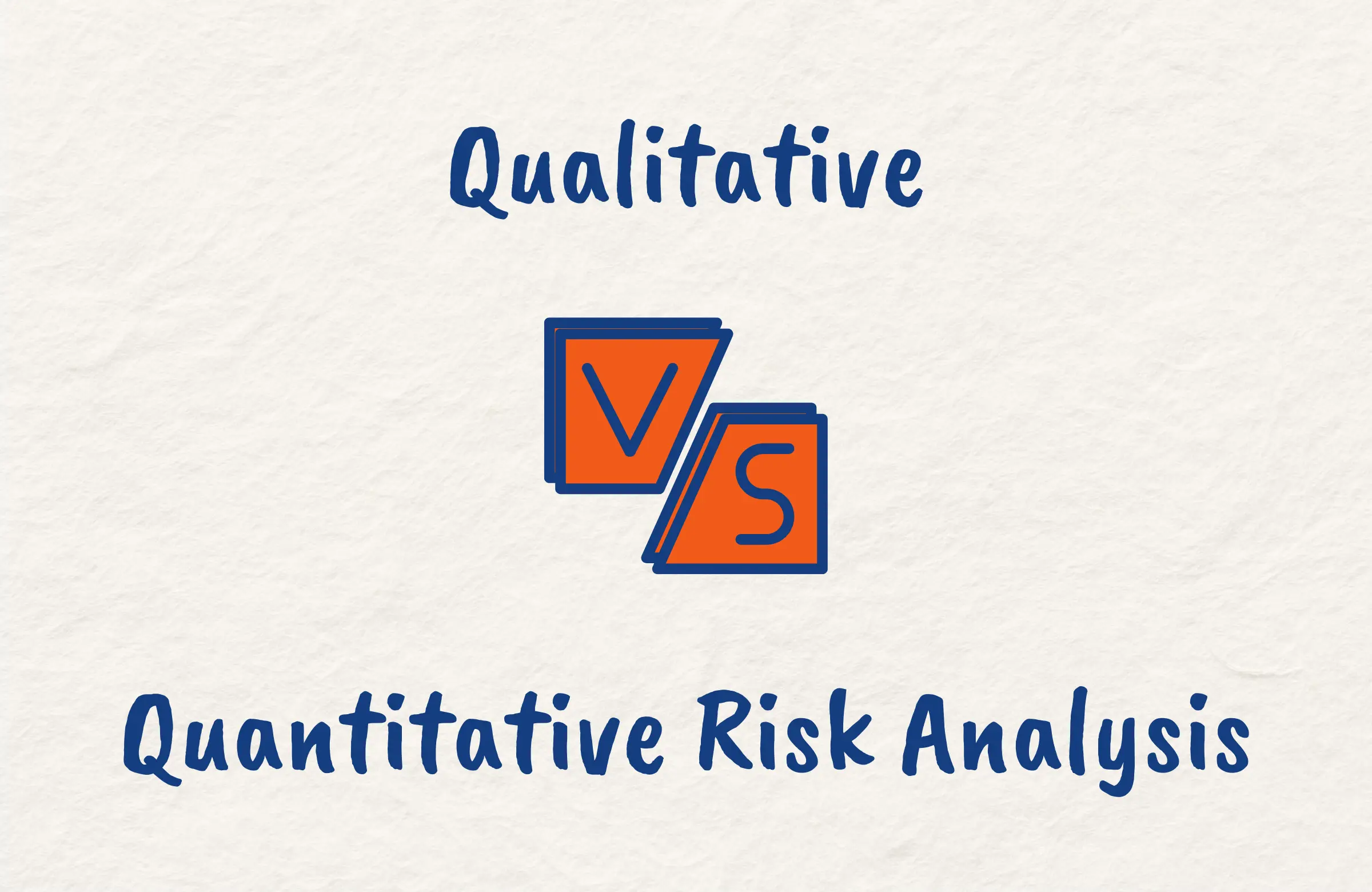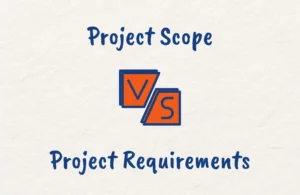Risk management is a critical factor when managing projects to ensure project success. An important part of risk management is performing risk analysis to assess and prioritize various project risks.
Two main techniques for analyzing risks are qualitative and quantitative risk analysis which take different but complementary approaches to the overall project risk management.
In this post, we’ll compare qualitative vs quantitative risk analysis in detail to fully understand the differences between both techniques and how to utilize them individually and together to get better insights into project risks.
Qualitative vs Quantitative Risk Analysis Overview
Bottomline Upfront: The main difference between both of them is that qualitative risk analysis focuses on the subjective assessment of the probability and impact of identified project risks to determine their risk rating, while quantitative risk analysis utilizes numerical data to quantify the potential risk impact of the overall project.
As you read on in this article, these differences are explained further in-depth.
What is Qualitative Risk Analysis in Project Management?
Qualitative risk analysis is a subjective assessment method used to prioritize project risks based on their probability of occurring and their potential impact on objectives.
In qualitative analysis, you examine each identified risk and estimate the likelihood of it happening along with its effect if it does happen. Qualitative assessments rely heavily on the judgment of experts and stakeholders to evaluate risks.
Common techniques used in this process include:
- Brainstorming sessions
- Interviews with experts and project team members
- Using a risk assessment matrix to assign ratings
- Risk categorization to group risks
- Reference to historical information
The goal is to assign each risk a risk rating reflecting the risk exposure. Ratings can be numeric scales like 1-5 or textual ratings like low-medium-high.
A risk assessment matrix with probability and impact criteria is commonly used to derive risk ratings where risks are plotted on the matrix based on their probability and impact scores.
Outputs of qualitative analysis include an updated risk register with risk ratings and a prioritized list of high-priority risks.
Qualitative assessments give a great overview of risk exposure and are easier to perform compared to quantitative methods. However, they can be prone to bias as they depend heavily on human perception.
What is Quantitative Risk Analysis in Project Management?
Quantitative risk analysis provides numerical assessments of the overall impact of project risks by evaluating the combined effect of all identified risks on objectives like schedule, cost, scope, etc.
While qualitative analysis focuses on individual risks, quantitative analysis looks at risks collectively and uses data modeling to provide probabilistic forecasts for project outcomes.
Common techniques used for quantitative analysis include:
- Decision tree analysis
- Sensitivity analysis
- Monte Carlo simulations
- Calculating expected monetary value (EMV)
Quantitative analysis requires accurate data on risk probability, impact cost, and other variables. Historical data, subject matter expert estimates, etc. are used to determine risk data.
The risk ratings from qualitative analysis are further refined using risk data. Often risks are evaluated in terms of their monetary value and impact on objectives.
Key outputs of quantitative analysis are:
- A quantitative risk register with numerical ratings
- Risk prioritization as per quantified exposure
- Estimates for contingency reserves
Quantitative methods provide objective, statistically-valid assessments of overall risk. But they require significant effort, time, and data.
Key Differences Between Qualitative Risk Analysis and Quantitative Risk Analysis
Qualitative and quantitative risk analysis have some key differences even though they have some common objectives. Let’s examine the major points of variation:
Individual Risks vs Overall Risk
Qualitative analysis evaluates individual project risks like delays, cost overruns, etc., and focuses on discrete risks. In contrast, quantitative analysis looks at total project risk and evaluates the aggregated impact of all discrete risks acting together.
Subjective vs Objective
Qualitative assessments rely on subjective criteria and expert judgment for evaluating risks. On the other hand, quantitative analysis is driven by objective data like numerical probabilities, cost estimates, etc.
Risk Rating
Qualitative ratings use descriptive scales like low/medium/high or numeric scales from 1-5. Quantitative ratings are numerical values like expected monetary impact in dollars.
Ease of Use
Qualitative methods are relatively easy to apply even for smaller projects, while quantitative risk analysis requires extensive data collection and tools, so is suited for large projects.
Precision
Qualitative risk analysis gives directional insights into risk priorities. In comparison, quantitative analysis provides statistically robust estimates of risk impact.
Techniques Used
Qualitative risk analysis techniques include interviews, the Delphi method, risk categorization, etc., while quantitative techniques include decision trees, sensitivity analysis, Monte Carlo simulation, etc.
Key Outputs
Qualitative risk analysis provides a prioritized list of risks with ratings. In contrast, quantitative risk analysis provides risk financials, contingency reserves, risk model forecasts, etc.
How to Perform Qualitative and Quantitative Risk Analysis
Performing qualitative and quantitative risk analysis involves following a systematic process to evaluate and prioritize project risks.
How to Perform Qualitative Risk Analysis
Qualitative risk analysis involves assessing and prioritizing risks based on their likelihood of occurring and the impact they could have on project objectives. Here are the key steps:
1. Identify Potential Risks
First, use techniques like brainstorming, interviewing experts, and reviewing project documents to identify all potential risks that can affect your project. Document the risks in detail in a risk register including risk causes, impacts, and other relevant details.
2. Assess Probability and Impact
For each identified risk, assess:
- The probability or likelihood of the risk occurring, on a simple high/medium/low scale based on expert judgment.
- The impact or effect the risk would have on your objectives like schedule, cost, scope, etc. if it did occur. Again use qualitative ratings like high/medium/low based on expert opinions.
3. Derive Risk Ratings
Next, use a risk assessment matrix that defines different probability and impact criteria to derive an overall risk rating for each risk. Plot each risk on the matrix based on its probability and impact to determine if it has a high, moderate, or low rating.
4. Prioritize Risks
Prioritize all risks based on their ratings. Risks with high ratings are of higher priority than the low-rated risks.
5. Document in the Risk Register
Document the probability, impact, and overall rating for each risk in the risk register.
How to Perform Quantitative Risk Analysis
Quantitative risk analysis numerically estimates the overall impact of risks on project objectives. The key steps are:
1. Gather Risk Data
Collect accurate numerical data on risk probabilities, impacts, and other variables. Use historical data, subject matter expertise, and other sources.
2. Develop Risk Models
Use the risk data to build a model depicting all identified risks and their relationships. Outline probability distributions and correlations.
3. Run Simulations
Run Monte Carlo simulations on the risk model to estimate the potential project outcomes considering risk interactions. Determine the probability of achieving objectives.
4. Calculate Risk Impact
Analyze simulation results to quantify the overall risk impact on objectives like cost, time, etc. Calculate risk financials like expected monetary value.
5. Refine Risk Priorities
Refine the priority of risks based on the quantified impact. Update the risk register with new ratings.
6. Estimate Reserves
Recommend contingency reserves based on the potential risk impact. Maintain reserves to cover high-priority risks.
7. Document Risks
Document the quantitative ratings, risk modeling approach, simulations, impact data, and re-prioritized list in the risk register.
When Would You Choose Qualitative Over Quantitative Risk Assessment?
While you can use both risk analysis techniques for some projects, qualitative analysis is usually preferred over quantitative in certain scenarios as it offers a lightweight, flexible way to gain quick risk insights.
Some of these scenarios include:
1. Smaller, Simple Projects
For smaller, straightforward projects with limited risks, the qualitative assessment provides sufficient insights into risk priorities as the additional effort for quantitative is not warranted.
2. Early Project Stages
In the early stages, when risks are still being identified, a qualitative analysis helps quickly prioritize them for response planning. Detailed quantitative assessment can come later.
3. Limited Data
Where reliable risk data is lacking, expert judgment during qualitative assessment adds value for initial risk screening. Numeric data can be gathered later for quantitative analysis.
4. Resource Constraints
With tight budgets or schedules, qualitative allows faster, cheaper analysis to determine priority risks and responses as quantitative analysis requires significant time and cost.
5. Uncertain Requirements
For projects with unclear or evolving requirements, qualitative provides flexibility to accommodate changing risk perceptions.
6. Stakeholder Alignment
Qualitative analysis and risk matrices aid discussion and alignment among stakeholders on risk ownership and response.
Qualitative vs Quantitative Risk Analysis PMP Exam Tips
Qualitative and quantitative risk analysis are important topics for the PMP exam under the Perform Qualitative Risk Analysis and Perform Quantitative Risk Analysis processes.
Some tips for exam questions:
- Know the inputs, tools and techniques, and outputs (ITTOs) of both processes from the PMBOK guide.
- Understand the differences between qualitative and quantitative analysis in terms of objectives, evaluation techniques, outputs, etc.
- For situational questions, recognize when qualitative analysis is preferable e.g. for smaller, less complex projects.
- For quantitative questions, be familiar with techniques like decision trees, sensitivity analysis, Monte Carlo simulations, etc.
- Know that quantitative analysis produces key outputs like risk models, numerical risk ratings, and risk financials, and how they are used.
- Recognize how the risk register gets updated after qualitative and quantitative processes.
- Understand the sequence; qualitative analysis happens first to prioritize risks, followed by quantitative for detailed numerical analysis.
- Expect questions testing your grasp of concepts like risk probability, impact, risk score, risk rating, risk matrix, etc.
Getting clarity on these key points as per the PMBOK will help you answer situational and theory questions confidently.
Qualitative vs Quantitative Risk Analysis Example
Let’s understand qualitative and quantitative risk analysis with an example project.
Sarah is managing a 6-month website redesign project with a budget of $100,000. In the identify risks process she has documented 10 potential risks that can impact schedule and cost objectives.
For qualitative analysis, she assesses each risk’s probability of occurring as high/medium/low. She also estimates the impact as high/medium/low if the risk occurs.
Using a risk matrix with defined probability and impact scales, she derives a risk score for each risk. Based on the scores, risks are assigned a rating of High, Moderate, or Low.
The qualitative risk register contains the probabilities, impacts, scores, and ratings for all identified risks with the high-rated risks prioritized for further analysis.
Then for top risks, she performs quantitative analysis and collects numerical data on risk probabilities, cost impacts, durations, etc.
She builds a risk model showing risk correlations and uses Monte Carlo simulations. The simulations estimate the overall risk impact on project cost to be $12,500 and schedule overrun to be 3 weeks.
She calculates the expected monetary value of key risks and refines the risk priority list accordingly. The quantitative risk register documents the risk financials, model elements, and quantitative ratings.
Based on the analysis, Sarah plans risk responses like mitigation and contingency reserves. During project monitoring and control, she tracks identified risks and implements responses as needed.
In this example, qualitative analysis provided a prioritized list of key risks to focus on, while quantitative gave dollar estimates of overall risk impact. Their integrated use allowed robust risk evaluation.
Conclusion
Having a sound risk management process is critical in project management. Qualitative and quantitative risk analysis allow you to thoroughly assess and understand project risks.
While both techniques have the same aim, qualitative relies on expert judgment to prioritize risks while quantitative provides data-driven numerical analysis. Integrating these two complementary methods will provide the most robust risk insights and help you proactively minimize threats to your project.
With a clear grasp of these concepts, you can choose the right type of analysis and develop effective risk responses to achieve project success.





